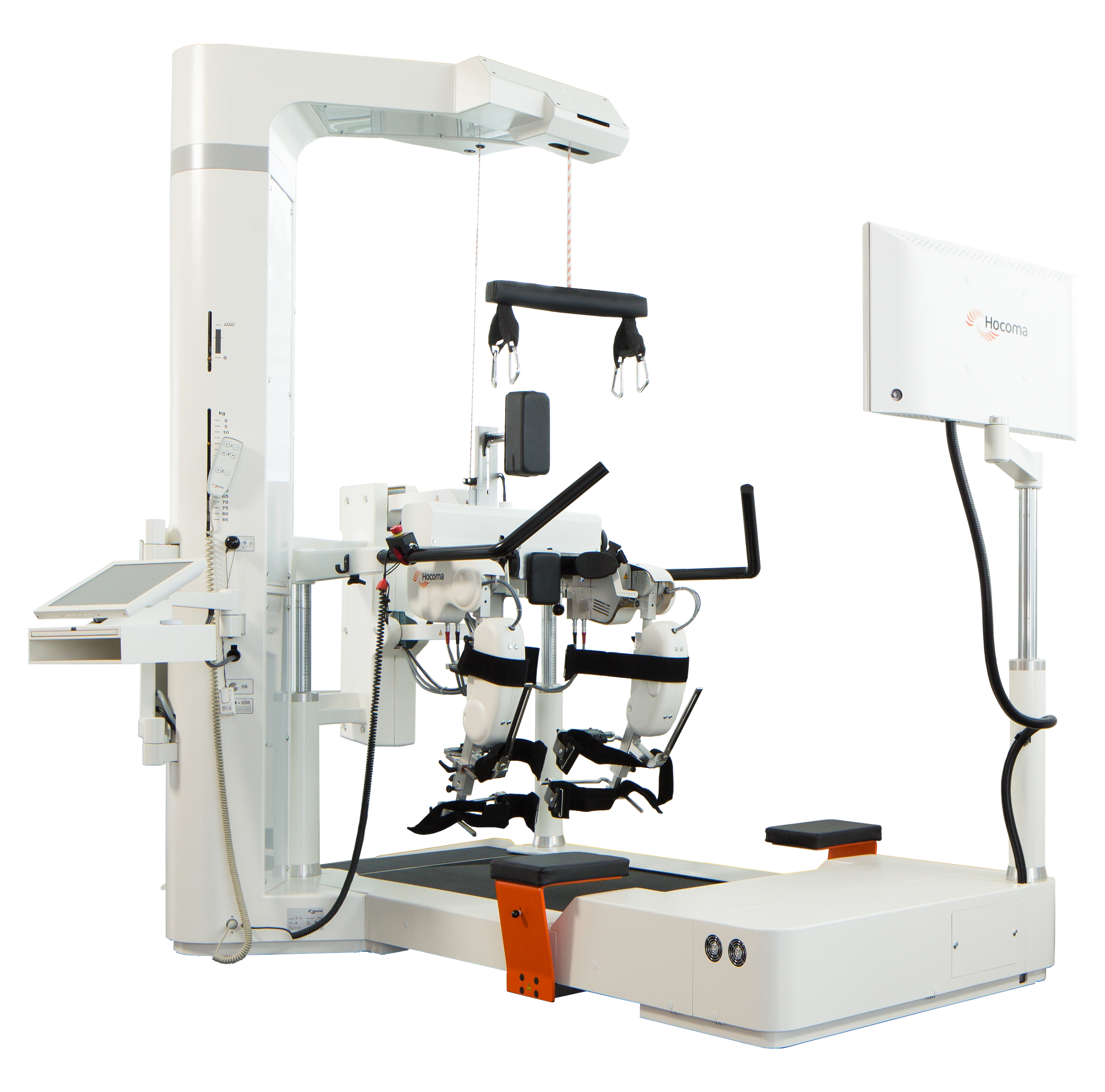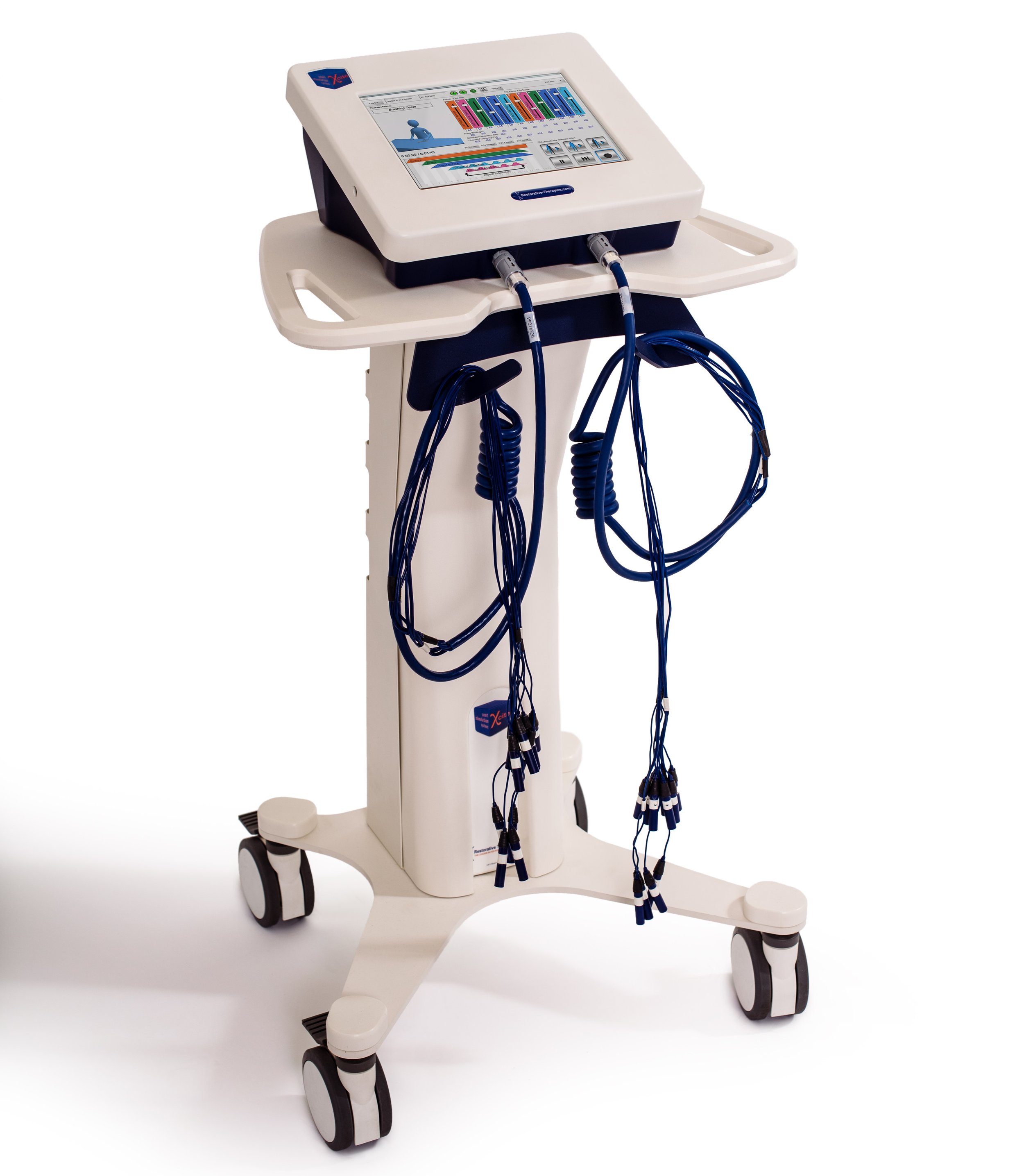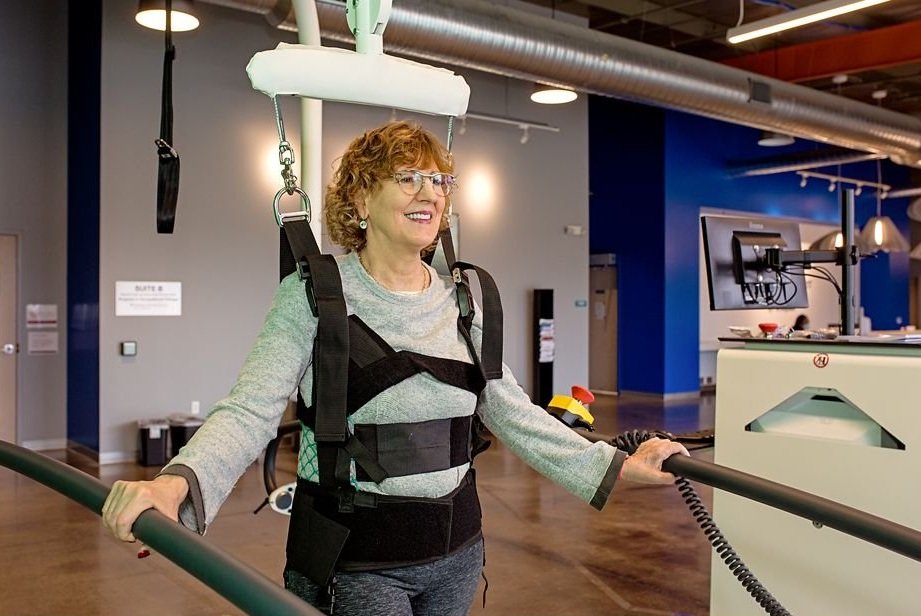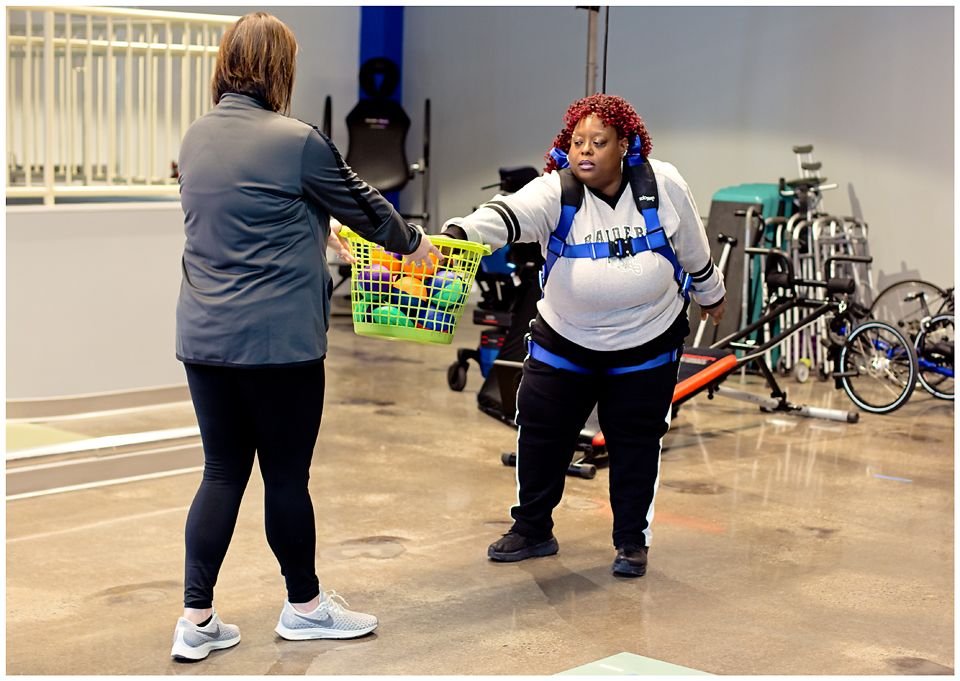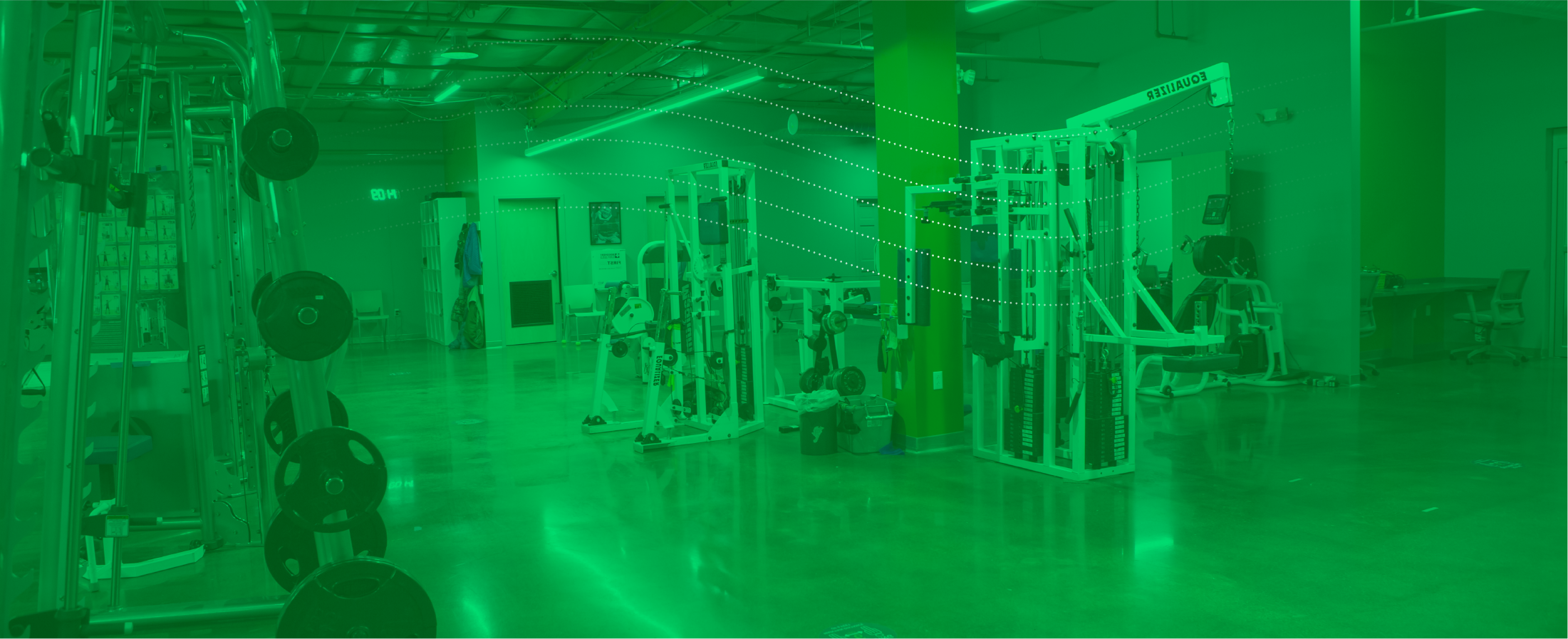
Advancing Fitness with Specialized Equipment
Adaptive Exercise Equipment
Equipment listed here can be utilized independently, during open gym hours. In addition to the equipment found in many traditional gyms, such as treadmills and free weights.
The Orthwein Center offers extensive adapted equipment, including:
LiteGait®
ParaMill (wheelchair treadmill)
Standing frames
VitaGlide®
Mobility Skills Course with ramps, curbs and stairs for training with assistive devices
NuStep® recumbent cross trainers
MOTOmeds®
Krankcycles®
SCIFIT® steppers, elliptical, and bikes
Solo-Step® overhead track and harness system
Wheely X (wheelchair treadmill)
Equalizer strength equipment
Lifetime cable equipment
Smith machine
Paralympic powerlifting bench
GaitKeeper treadmill
Xcite
Parallel bars
SaeboMAS

Specialty Exercise Equipment
Equipment listed here can only be utilized during 1:1 Exercise Training sessions with an Adaptive Exercise Specialist, with the exception of the Solo-Step®.
Alter G
-
The AlterG® Anti-Gravity Treadmill features patented, NASA Differential Air Pressure (DAP) technology, a precise air calibration system, based on the user’s actual body weight, to change what’s possible in rehab and training. Using a pressurized air chamber to uniformly reduce gravitational load and body weight in precise 1% increments, AlterG enables patients and athletes to move unrestricted and pain-free – restoring and building muscle strength, range of motion, balance, function, and fitness. Unique technology allows for normal gait and balance unlike hydrotherapy or harnesses – for superior weight-supported walking, running, and closed kinetic-chain exercise.
-
An AlterG Anti-Gravity Treadmill™ system will help you experience a level of freedom you may not have thought possible. Whether you want to get back to life as quickly as possible after orthopedic injury or surgery, or you want to gain strength and endurance while managing a neurological condition, chronic disease, or obesity – AlterG can give you new power to achieve your goals.
-
The AlterG® Anti-Gravity Treadmill features patented, NASA Differential Air Pressure (DAP) technology, a precise air calibration system, based on the user’s actual body weight, to change what’s possible in rehab and training. Using a pressurized air chamber to uniformly reduce gravitational load and body weight in precise 1% increments, AlterG enables patients and athletes to move unrestricted and pain-free – restoring and building muscle strength, range of motion, balance, function, and fitness. No other unweighting technology offers as much precision, accuracy and comfort.
Armeo®Power
-
Armeo®Power by Hocoma is a robotic exoskeleton that has been specifically designed for arm and hand therapy, enabling even clients with severe motor impairments to perform exercises with a high number of repetitions. This device uses Performance Feedback exercises designed to train strength and range of motion needed for activities of daily living.
-
Conventional arm and hand therapy can limit the number of repetitions and severity can prevent practice. The Armeo®Power can assist individuals with little movement to improve range of motion and fine motor skills for individuals with neurological injuries.
-
The Armeo®Power carries the weight of the client’s arm and hand and allows training in an extensive workspace. The robotic arm assistance can be adapted to the individual needs and changing abilities of each client — from full assistance for clients with very little activity to no assistance.
C-Mill
-
C-Mill by Hocoma is motivational treadmill training that uses augmented and virtual reality to simulate everyday life and maximize results. The C-Mill offers body-weight support, force plates, and extensive data reporting.
-
Training on the C-Mill benefits people who would like to improve their standing balance and walking, including people with lower extremity amputations, Parkinson’s disease, stroke, cerebral palsy, and brain injury.
-
The C-Mill helps people train to successfully navigate everyday circumstances, like walking in a crowd or avoiding obstacles. A wide range of exercise games incorporate external focus, varied environments, and performance feedback to keep you engaged and challenged.
Galileo
-
Galileo is an efficient universal exercise-training tool for improving muscle fitness, enhancing performance in athletes, and for use in space research. It’s sea-saw side-alternating movement pattern simulates the natural human gait causing a tilting movement of the pelvis, just like when walking but at a more rapid pace.
Unlike other muscle stimulation devices, Galileo Training recruits the afferent and efferent system putting small and large antagonistic muscle groups through thousands of muscle contractions – all in a matter if minutes. Not only is Galileo easy to use, but also efficient, low impact training that improves users balance, coordination, muscle function, muscle power, muscle force and neural communication.
-
Not only does Galileo Training accelerate early rehabilitation for children to seniors with neurological conditions, it also optimizes “motor relearning” under the principle of high-repetition to increase neuroplasticity and decrease the complications of long-term immobility. As a rehab intervention, Galileo Training is a highly effective tool to modify spasticity prior to functional muscle training and mobility.
-
Galileo’s side-alternating motion is similar to a seesaw movement with variable amplitude and frequency, and therefore stimulates a movement pattern similar to human gait. The rapid movement of the training platform causes a tilting movement of the pelvis, just like when walking, but much more frequently.
EksoNR™ (exoskeleton)
-
EksoNR™, manufactured by Ekso Bionics®, is a wearable robotic exoskeleton that helps clients with stroke, acquired brain injury, and spinal cord injury stand and relearn to walk with a trained therapist. This cutting-edge exoskeleton technology helps clients get back on their feet sooner to re-learn correct step patterns, weight shifting, and posture.
-
EksoNR™’s smart software allows clinicians to adjust settings based on a client’s weaknesses and tailor each individual session. The goal with EksoNR™ is to progress clients during their training so they can regain as much function as possible in order to “walk out” of the device.
-
The Armeo®Power carries the weight of the client’s arm and hand and allows training in an extensive workspace. The robotic arm assistance can be adapted to the individual needs and changing abilities of each client — from full assistance for clients with very little activity to no assistance.
Erigo® Pro
-
Erigo® by Hocoma combines cyclical, robotically generated leg movement with functional electrical stimulation (FES) in a supported upright position to facilitate central nervous system stimulation, weight-bearing, and cardiovascular stability.
-
People who benefit from supported standing and stepping, facilitated strengthening, and sensorimotor stimulation, including people with spinal cord injury, stroke, and brain injury.
-
The Erigo gradually raises the person to an upright position on a tilt table while robotic foot plates generate stepping. Optionally, functional electrical stimulation (FES) can also be applied to the person’s legs. This helps maximize muscular strength and neurological stimulation. Once upright, the person can also work on upper extremity strengthening or stretching.
Lokomat®
-
The Lokomat® by Hocoma is the best investigated device in robot-assisted gait rehabilitation today. Robot-assisted therapy enables effective and intensive training to increase the strength of muscles and the range of motion of joints in order to improve walking.
-
The Lokomat® is intended to assist with gait training of people with gait deficits as well as secondary benefits of upright mobility for individuals without lower extremity movement. The Lokomat® has been known to benefit those with spinal cord injury, traumatic brain injury, stroke, cerebral palsy, Parkinson’s disease, and multiple sclerosis. Screening is needed prior to getting in the device.
-
Robot-assisted gait is sized to the individual to promote the mechanics of walking. The physiological movement of the lower extremities is ensured by the individually adjustable client interface. Additionally, virtual reality games can increase performance and challenge the individual.
RT300 Leg|Arm|Core Cycle
-
Use a state-of-the-art functional electrical stimulation (FES) cycle, the RT300 Leg|Arm|Core, to increase strength, decrease spasticity, improve circulation, and improve range of motion.
-
FES benefits people with a wide range of neurological impairments including spinal cord injury, stroke, multiple sclerosis, cerebral palsy, brain injury, and more.
-
Electrical impulses are delivered through electrodes to stimulate nerves, which evoke a muscle contraction. Electrodes are placed on target muscle groups in the legs, abdominals, trunk, shoulders, and/or arms to allow active cycling with either arms or legs. All settings are customized, and appropriate levels of resistance and stimulation are applied to optimize each session’s results.
Xcite
-
Addresses neurological impairments or muscle weakness through functional electrical stimulation (FES) evoked movements such as reaching, standing up, and transferring.
-
FES benefits people with a wide range of neurological impairments including spinal cord injury, stroke, multiple sclerosis, cerebral palsy, brain injury, and more.
-
Electrical impulses are delivered through electrodes to stimulate nerves, which then evoke a muscle contraction. The Xcite has a library of stimulation patterns that activate the right muscles at the right time to achieve a functional movement or to complete an exercise.








